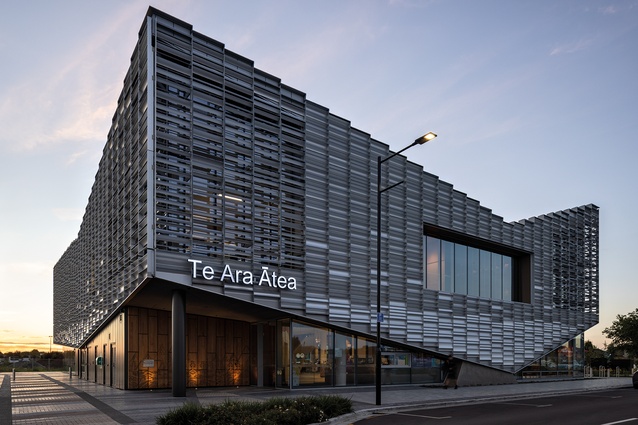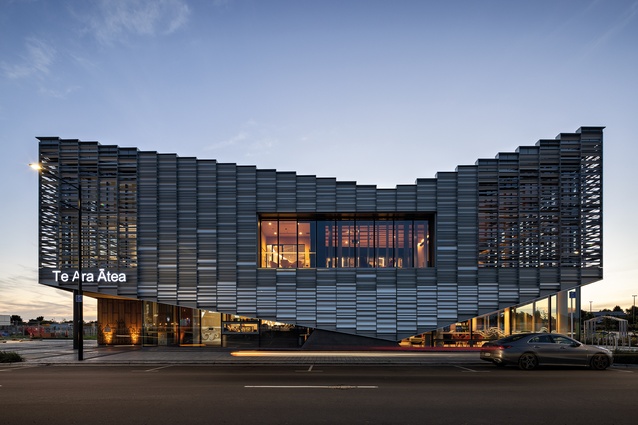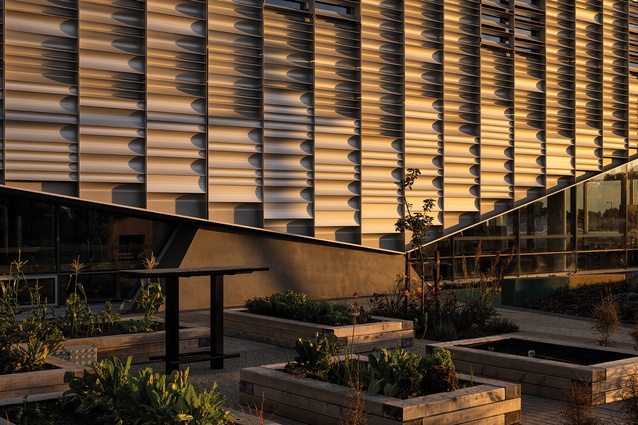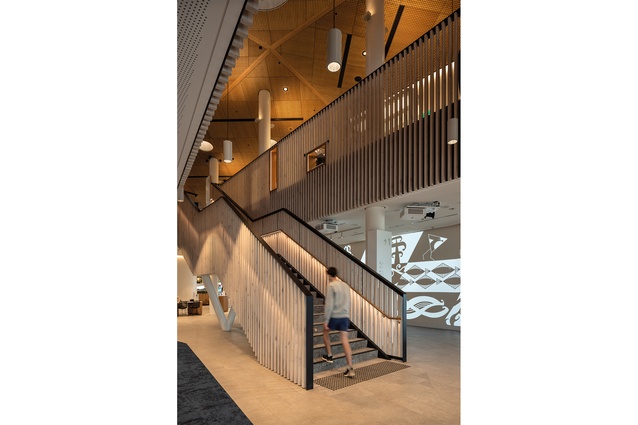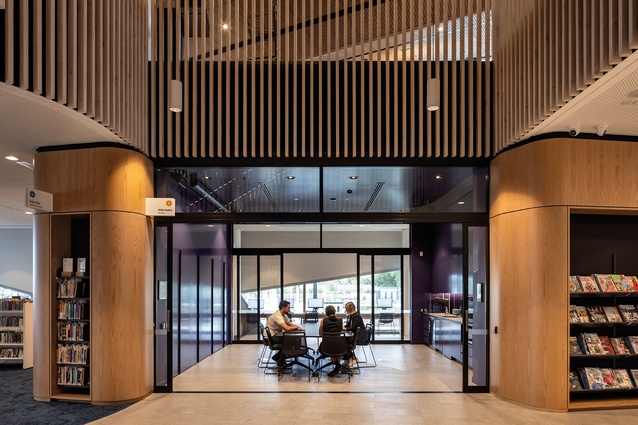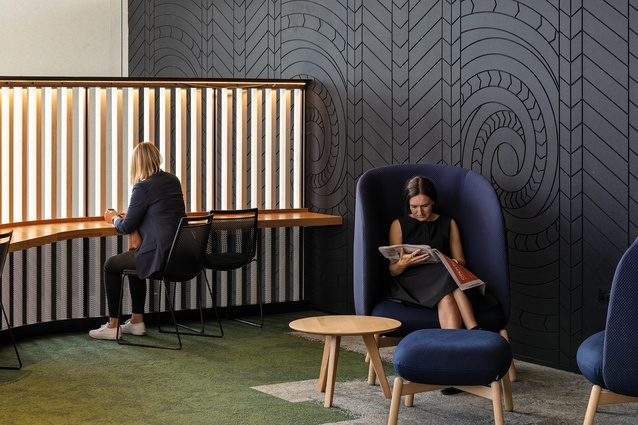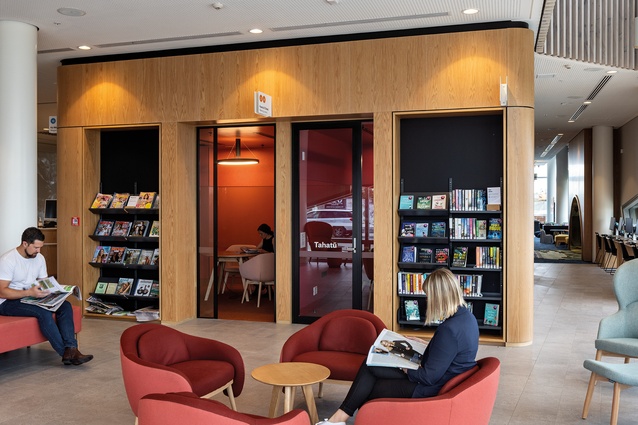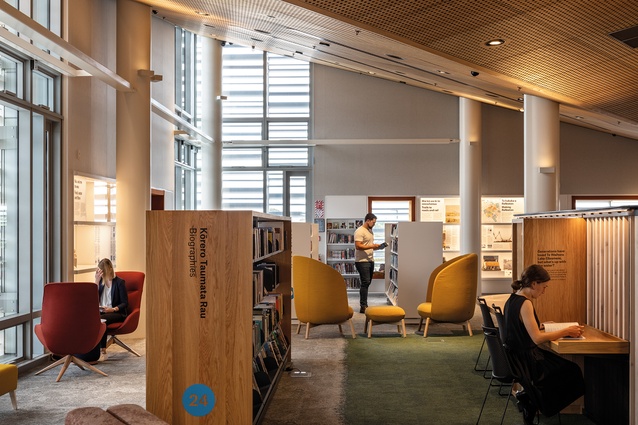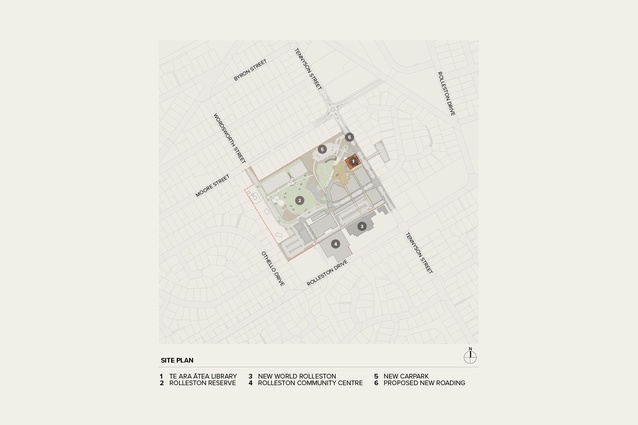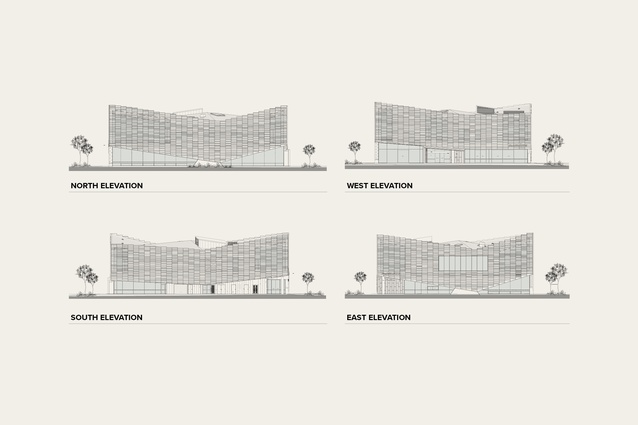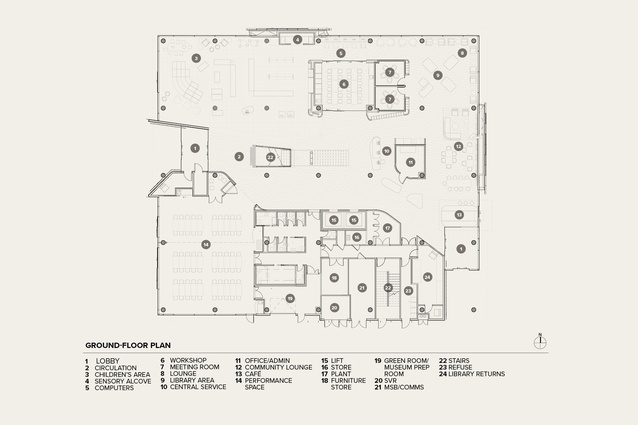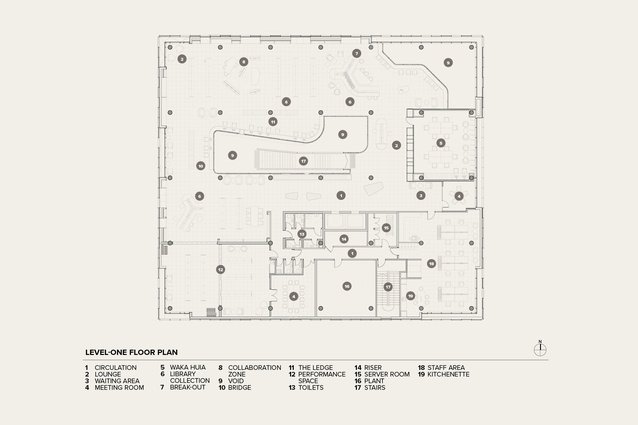Honed to shine
Abigail Hurst contemplates the multiple forces at play in Rolleston’s new multifunctional library, Te Ara Ātea by Warren and Mahoney.
As I take the new Christchurch Southern Motorway for about 20 minutes southwest from Christchurch city, then turn left off State Highway 1, a glimmering, angled object, much taller than the single-level houses and shops in its proximity, catches my eye. This is Te Ara Ātea, a building designed as a beacon to its community and a striking first step for the Selwyn District Council in its plan for Rolleston Town Centre.
Te Ara Ātea’s functions are diverse – a hybridised library, museum, community and performance facility – and a reflection of the needs of the people in today’s Rolleston. It joins the global trend of libraries as democratic, accessible, neutral spaces in which to relax and socialise – much more than just a place to borrow books. Despite the many driving forces of the brief, rounds of dreaded value engineering during its design and various Covid-19 lockdowns throughout its construction period, the project has endured. In fact, Te Ara Ātea has been carefully honed to shine.
Coined the ‘Town of the Future’ by Prime Minister Norman Kirk in the 1970s, Rolleston remained a place with a population of fewer than 1000 until the 1990s and the small group of houses caused its catchphrase to be said in jest when driving by. No laughing matter now: this town is home to an estimated 24,700 people, the increase fuelled in part by those relocating after the Canterbury earthquakes. Land stability and economic pricing of property – up until 2021, a new four-bedroom house on a 600m2 section could be bought for around $550,000 – made Rolleston attractive, especially to families who wanted a fresh start after their houses and neighbourhoods were damaged. As the town grew and standard subdivisions were built, one after the other, so, too, did the need for an identifiable town centre grow.
The name Te Ara Ātea was gifted to the project after consultation with Te Taumutu Rūnanga and can be translated as ‘an unobstructed trail to the world and beyond’. The name links to Rolleston’s rich past as it is situated in a network of ara tawhito (ancient trails) that were marked on the flat landscape to lead Māori to mahinga kai sites. It is a name that, additionally, hints at its position as the main railway junction between Greymouth and Main South Line from the 1880s to the 1980s. Te Taumutu Rūnanga also gave a story about the braided river that once swept through Te Ara Ātea’s site to the project. There was a battle between a taniwha named Tū Te Rakiwhānoa, who cared for and moved through the waterway between the river and lake, and Te Maru, the north-west wind that raged through the mountains and blew rubbish into the river. Tū Te Rakiwhānoa decided to build a dam to stop the waste from entering his waterways. While Tū Te Rakiwhānoa rested from his hard work, Te Maru found Tū Te Rakiwhānoa’s dam and was very angry, blowing a gale that tore down the taniwha’s work and created the gap in the mountains – the Rākaia Gorge – and a new pathway.
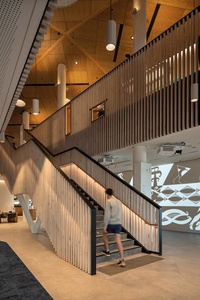
This story drove the design process of Te Ara Ātea from beginning to end. A meandering pathway has been cut through the centre of the building’s plan, emphasised by a 35m-long, curved digital art wall. From this path, patrons flow with ease to and from the central, internal void space and to the building’s four corners – each one with a distinct function. The entrance off Tennyson Street is through the eastern corner and lobby, a café and community lounge area stretching to the north extent of the building. The tamariki space occupies the ground-floor, north-west corner, with large sliding doors and a more relaxed approach to book security enabling it to be opened up to the landscaped area beyond on sunny days. The final quadrant is a performance space with a green room behind, also openable to Rolleston’s yet-to-be-realised town square and retail precinct. The floor here is designed so that a scout tank can be driven into it to celebrate another part of Rolleston’s history – its tie to the military and proximity to Burnham Camp.
As I rise above the buzz of activity and climb the central stair, there is a sense of procession on entering the quieter first floor. The Waka Huia room (named after a carved box that Māori use to hold treasure) is in the immediate line of sight and provides a research area with a view. Containing the one significant window of the building, it looks out east to Banks Peninsula, the flora and fauna that Tū Te Rakiwhānoa cared for along his waterway. Taonga are housed within a display wall: behind glass, but accompanied by digital screens offering 3D scans of the objects, allowing further engagement. In the main space, plush, orange reading nooks punctuate the upstairs solid walls between books and crafted gallery display boxes that continue the museum experience within this multifunctional library. High, timber-slatted balustrades fence voids and views through to the ground floor, dappled light entering from the façade and encouraging use of the building’s edges.
Encapsulating the Waka Huia room on a grander scale, Te Ara Ātea is a treasure trove with gems hidden around each corner. Also included is an open workshop, complete with a kitchenette, 3D printers, robotics, games, music equipment and production tools. A sensory nook designed especially for patrons on the autistic spectrum is tucked beside the tamariki space, and dispersed throughout are meeting rooms and gathering areas. Opportunities to display the work of local artists are also interwoven throughout. It is with these many activities that Te Ara Ātea cares for and nurtures its occupants, creating potential for more community input and allowing its users many ways forward to learn, discover and explore.
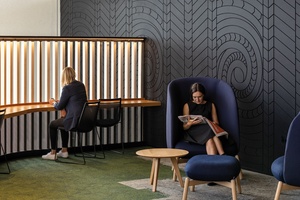
While the inside of Te Ara Ātea is curved, the exterior is intentionally angled to bring contrast. Each of the four corners is emphasised: lifted up from the ground below to achieve a 16m height – quite a feat for a two-storey building – and giving the building the scale needed to achieve ‘anchor project’ status. The façade brief posed a challenge, with the client desiring a building that shone but didn’t blind anyone while doing so. Scalloped aluminium louvres were proposed and, after many iterations and models, became the cloak of the building in vertical striations. This gives a successful shimmering-but-muted effect, harking back to the water by looking much like the pock-marks left in the sand on the sides of a riverbed and convincingly calling to mind something of the history of the site to its present form.
Although the client was not seeking formal green-star rating, Warren and Mahoney considered sustainability integral to its approach, working to achieve a highly insulated envelope with a warm roof and intelligent performance membranes, inside and out, controlling moisture. Simple key decisions, such as increasing the solid-wall-to-glazing ratio, also helped to reduce the energy demands of the building, while the clever façade system allows just the right amount of light inside. The external louvres reduce glare without significantly impacting daylighting on the interior, translating to an 18 per cent reduction in cooling load and plant size. Multifunction sensors are used throughout the building to measure light levels, motion, occupancy, humidity, temperature, CO2 /VOC (volatile organic compounds) and energy consumption. This information is fed back to an advanced building management system, enabling automatic control of the electrical and mechanical systems. The façade is also key to the building’s mixed-mode ventilation, where the stack effect has been utilised with small, low-level windows on actuators (incidentally, also letting in the smells of the flora and fauna from the perimeter gardens) and roof stack cowls at the roof that assist to draw hot air up and out.
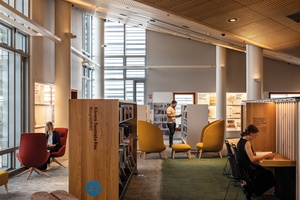
The care the architects have shown towards future sustainability and interior qualities of Te Ara Ātea rightfully reflects the responsibility bestowed upon them with the design of a public building. Without load-bearing walls (moment-resisting frames have been utilised), the building is also able to be easily retrofitted to suit new programmes, creating resilience for the future and an ability to respond to the unforeseen needs of the community. While each of the corners has a defined use, it also has versatility built in. The main performance space can be divided with a large acoustic wall and, with separate access points, two programmes can take place with ease. Directly above is a second performance space, currently full of book displays and storage but with the expectation that, when more books are borrowed over the next two years (30 per cent will then be expected to be loaned at any one time), it will be free for other uses. Innovations on offer will become more apparent in the years to come, to inspire and be of use to anyone who enters through the facility’s doors.
The many forces that have forged Te Ara Ātea have been united in one focus: to serve the community. Perhaps that is why, despite the many activities it contains, there is a sense of cohesion. It was always intended to be more than a cultural building – it was meant to be a space for living, too. Te Ara Ātea is a jaunty nugget of a building that packs a punch above its weight and shines for all to see – gatekeeper to the world of knowledge at the frontier of a change for the community of Rolleston. Te Ara Ātea signals a town ready to embrace the future.
Project information:
- Warren and Mahoney (architects)
- TMCo (electrical, mechanical, structure, civils, fire)
- AE Services (Acoustic Services)
- Kaizon (façade and building fabric engineering)
- Inovo (project management and administration)
- Workshop E (museum experience)
- Armitage Williams (main contractor)

